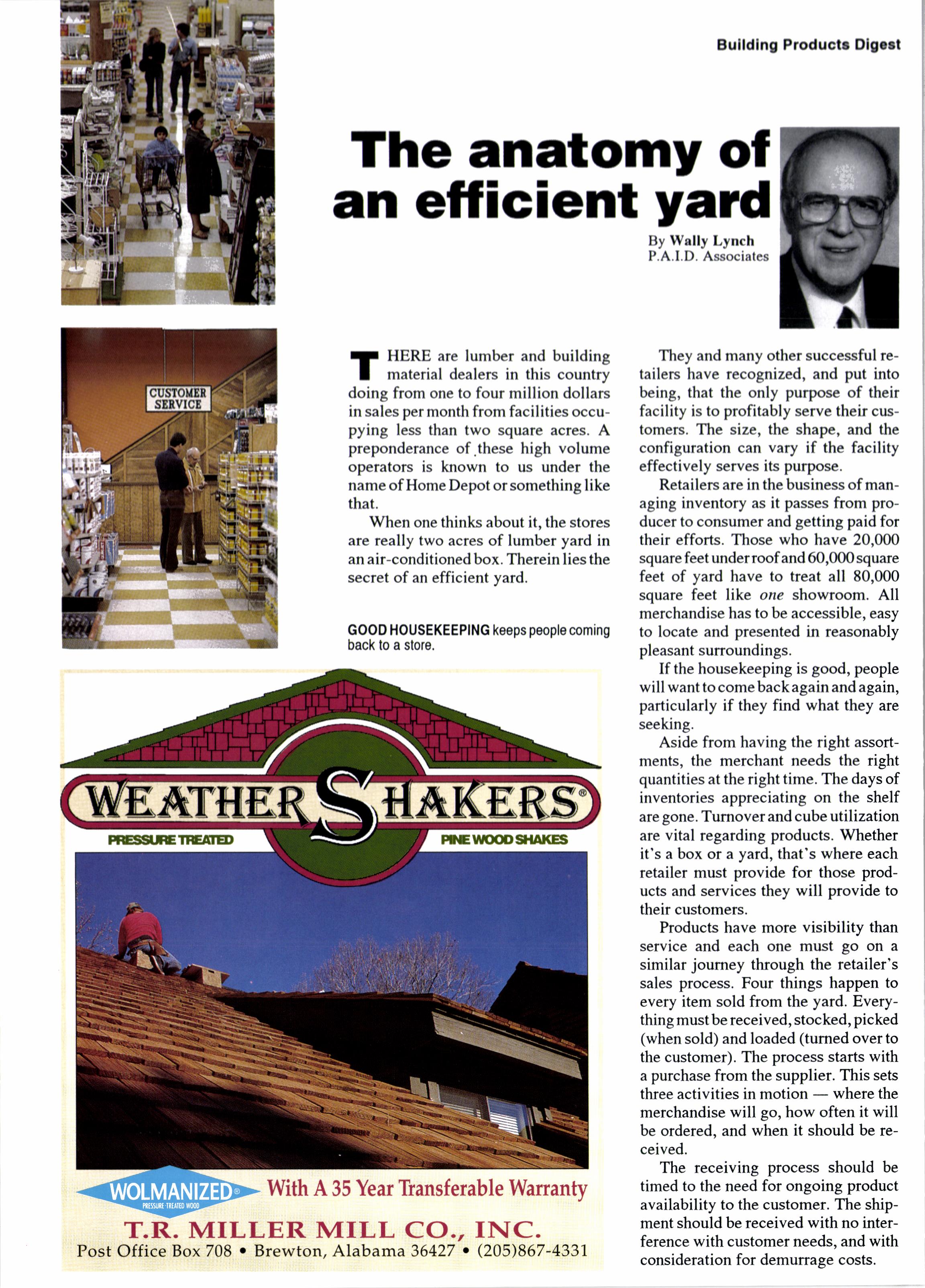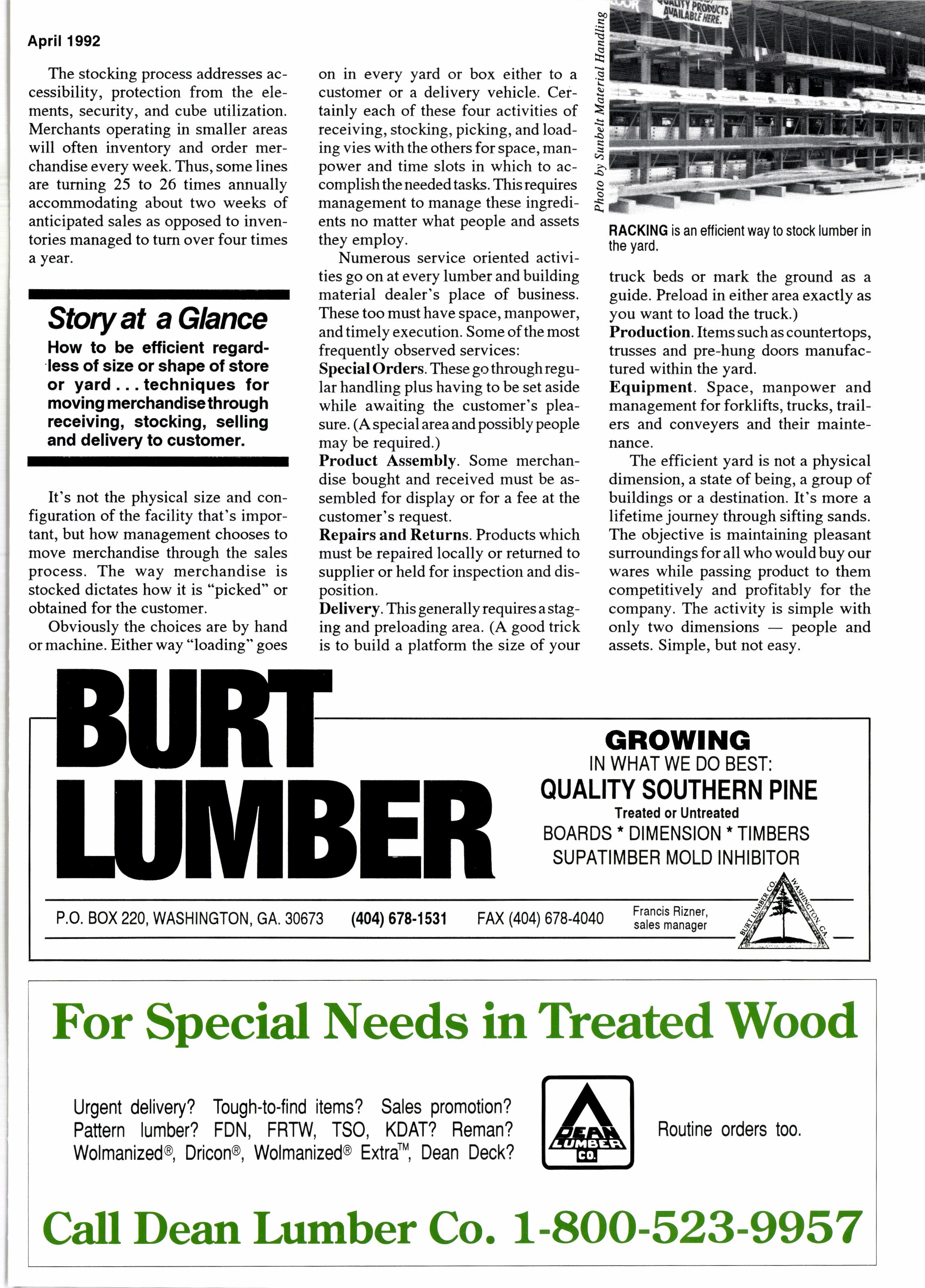
3 minute read
The anatomy of an efficient yad
By Wdly Lynch P.A.I.D. Associates
rJ HERE are lumber and building I material dealers in this country doing from one to four million dollars in sales permonth from facilities occupying less than two square acres. A preponderance of .these high volume operators is known to us under the name of Home Depot or something like that.
When one thinks about it, the stores are really two acres of lumber yard in an air-conditioned box. Therein lies the secret of an efficient yard.
They and many other successful retailers have recognized, and put into being, that the only purpose of their facility is to profitably serve their customers. The size, the shape, and the configuration can vary if the facility effectively serves its purpose.
Retailers are in the business of managing inventory as it passes from producer to consumer and getting paid for their efforts. Those who have 20,000 square feet underroof and 60,0(X)square feet of yard have to treat all 80,000 square feet like one showroom. All merchandise has to be accessible, easy to locate and presented in reasonably pleasant sunoundings.
Ifthe housekeeping is good, people will want to come back again and again, particularly if they find what they are seeking.
Aside from having the right assortments, the merchant needs the right quantities at the right time. The days of inventories appreciating on the shelf are gone. Turnover and cube utilization are vital regarding products. Whether it's a box or a yard, that's where each retailer must provide for those products and services they will provide to their customers.
Products have more visibility than service and each one must go on a similar journey through the retailer's sales process. Four things happen to every item sold from the yard. Everything must be received, stocked, picked (when sold) and loaded (tumed over to the customer). The process starts with a purchase from the supplier. This sets three activities in motionwhere the merchandise will go, how often it will be ordered, and when it should be received.
The receiving process should be timed to the need for ongoing product availability to the customer. The shipment should be received with no interference with customer needs, and with consideration for demurrage costs.
The stocking process addresses accessibility, protection from the elements, security, and cube utilization. Merchants operating in smaller areas will often inventory and order merchandise every week. Thus, some lines are turning 25 to 26 times annually accommodating about two weeks of anticipated sales as opposed to inventories managed to turn over four times a Year.
Storyat aGlance
How to be efficient regard- 'less of size or shape of store or yard...techniques for moving merehandisethrough receiving, stocking, selling and delivery to customer.
It's not the physical size and configuration of the facility that's important, but how management chooses to move merchandise through the sales process. The way merchandise is stocked dictates how it is "picked" or obtained for the customer.
Obviously the choices are by hand or machine. Either way "loading" goes on in every yard or box either to a customer or a delivery vehicle. Certainly each of these four activities of receiving, stocking, picking, and loading vies with the others for space, manpower and time slots in which to accomplish the needed tasks. This requires management to manage these ingredients no matter what people and assets they employ.
Numerous service oriented activities go on at every lumber and building material dealer's place of business. These too musthave space, manpower, and timely execution. Some of the most frequently observed services: Special Orders. These go through regular handling plus having to be set aside while awaiting the customer's pleasure. (A special area and possibly people may be required.)
Product Assembly. Some merchandise bought and received must be assembled for display or for a fee at the customer's request. Repairs and Returns. Products which must be repaired locally or returned to supplier or held for inspection and disposition.
Delivery. This generally requires a staging and preloading area. (A good trick is to build a platform the size of your truck beds or mark the ground as a guide. Preload in either area exactly as you want to load the truck.)
Production. Items such as countertops, trusses and pre-hung doors manufactured within the yard.
Equipment. Space, manpower and management for forklifts, trucks, trailers and conveyers and their maintenance.
The efficient yard is not a physical dimension, a state of being, a group of buildings or a destination. It's more a lifetime journey through sifting sands. The objective is maintaining pleasant surroundings for all who would buy our wares while passing product to them competitively and profitably for the company. The activity is simple with only two dimensionspeople and assets. Simple, but not easy.
For Special Needs in Treated Wood

Urgent delivery? Tough{o-find items? Sales promotion?
Pattern lumber? FDN, FRTW, TS0, KDAT? Reman?
Wolmanized@, Dricono, Wolmanizedo ExtratM, Dean Deck?










